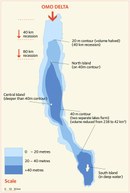What Future for Lake Turkana?
The Gibe III Dam, now being built in the middle basin of the Omo, will make possible large-scale commercial irrigation schemes in the lower basin. One of these schemes, now being implemented by the Ethiopian Sugar Corporation, will equal in extent the current irrigated area of Kenya. This will require a huge rate of water abstraction from the Omo, a transboundary river and the source of 90 per cent of Lake Turkana’s freshwater and accompanying nutrient inflow.
The actual irrigation water demand will depend not only on the crop area to be irrigated but also on the overall efficiency of the irrigation system. Making the optimistic assumption of an overall irrigation efficiency of 60 per cent, the paper predicts that the sugar scheme alone will require well over 30 per cent of the Omo flow. This rises to almost 40 per cent if the remaining area already allocated to irrigation development in the Lower Omo is included. If the efficiency assumption is reduced to 45 per cent (the figure used by the Omo-Gibe Master Plan of 1996) the total water demand for projected irrigation development in the Lower Omo reaches over 50 per cent.
This would lead to a drop in lake level of over 20 metres (its average depth is roughly 30 metres), a more than 50 per cent reduction in its volume and biomass (total mass of living organisms) and a drastic fall in the productivity of its fisheries. Ultimately, the lake could reduce to two small lakes, one fed by the Omo and the other by the Kerio and Turkwel rivers. The picture that emerges from these predictions bears a striking resemblance to the recent disastrous history of the Aral Sea, a non-outlet lake in Central Asia which was once the world’s fourth largest inland water body.
To download the paper click here.


